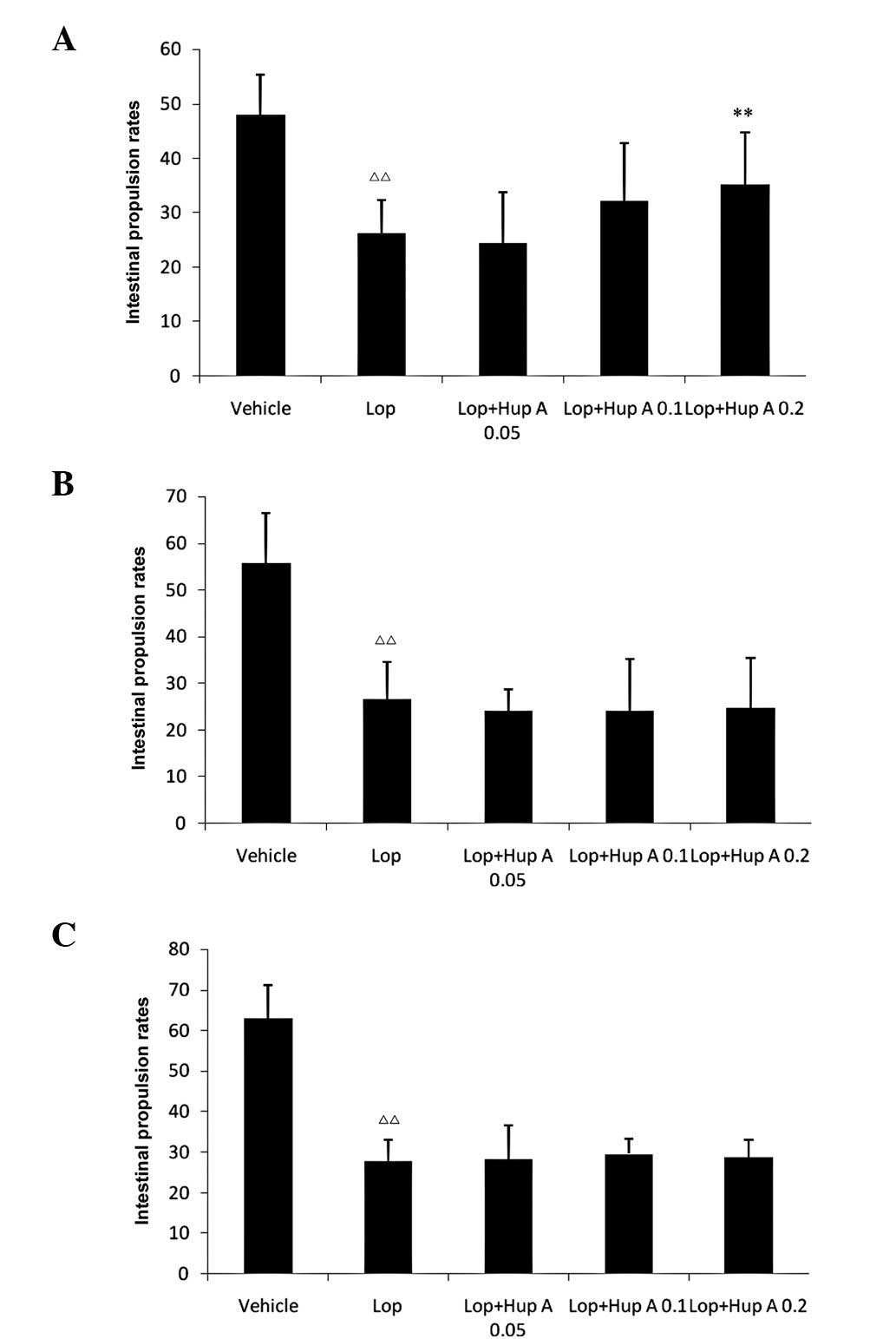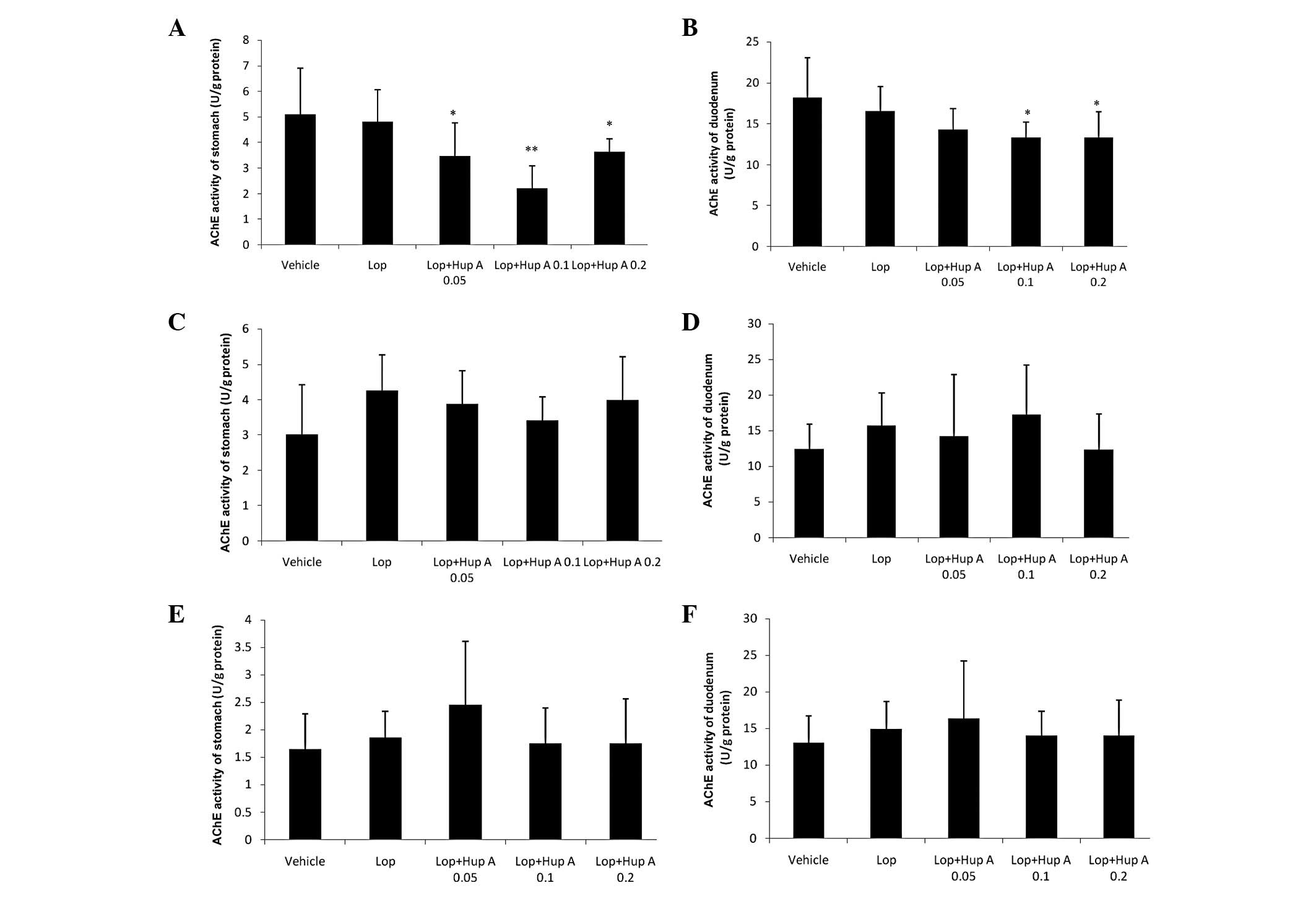The effects of huperzine A on gastrointestinal acetylcholinesterase activity and motility after single and multiple dosing in mice
- Authors:
- Leiming Zhang
- Yanqin Song
- Chengwen Lu
- Jianqiao Zhang
- Jiani Yuan
- Tian Wang
- Fenghua Fu
-
View Affiliations
Affiliations: Department of Pharmacology, School of Pharmacy, Yantai University, Yantai, Shandong 264005, P.R. China
- Published online on: January 4, 2013 https://doi.org/10.3892/etm.2013.883
-
Pages:
793-796
Metrics:
Total
Views: 0 (Spandidos Publications: | PMC Statistics:
)
Metrics:
Total PDF Downloads: 0 (Spandidos Publications: | PMC Statistics:
)
This article is mentioned in:
Abstract
The acetylcholinesterase inhibitor (AChEI), huperzine A has been used in the treatment of the cognitive deterioration associated with Alzheimer's disease (AD). However, the side-effects of huperzine A associated with increased cholinergic activity, particularly in the gastrointestinal system, are evident. It is not yet known how quickly these side-effects become tolerated; this information would provide guidance to doctors on how to use huperzine A so as to attenuate the adverse events. The present study aimed to observe the effects of huperzine A on gastrointestinal motility and acetylcholinesterase (AChE) activity in mice. After oral administration of huperzine A with single and multiple dosing, the gastrointestinal motility and AChE activity of the mice were examined. The results revealed that, following a single dose of huperzine A, the AChE activity in the stomach and duodenum were significantly inhibited and the gastrointestinal motility was significantly increased. However, following multiple doses (7 or 28 doses, one dose per day), no significant changes in the AChE activity and gastrointestinal motility were identified. These findings indicate that the gastrointestinal adverse effects of huperzine A may be well-tolerated relatively quickly and do not recur. Additionally, it suggests that patients with AD are likely to have minimal gastrointestinal side-effects after taking multiple doses of huperzine A.
View References
|
1.
|
Francis PT, Palmer AM, Snape M and Wilcock
GK: The cholinergic hypothesis of Alzheimer’s disease: a review of
progress. J Neurol Neurosurg Psychiatry. 66:137–147. 1999.
|
|
2.
|
Pohanka M: Cholinesterases, a target of
pharmacology and toxicology. Biomed Pap Med Fac Univ Palacky
Olomouc Czech Repub. 155:219–229. 2011. View Article : Google Scholar : PubMed/NCBI
|
|
3.
|
Birks J: Cholinesterase inhibitors for
Alzheimer’s disease. Cochrane Database Syst Rev.
25:CD0055932006.
|
|
4.
|
Mimica N and Presecki P: Side effects of
approved antidementives. Psychiatr Danub. 21:108–113. 2009.
|
|
5.
|
Farlow M, Veloso F, Moline M, et al:
Safety and tolerability of donepezil 23 mg in moderate to severe
Alzheimer’s disease. BMC Neurol. 11:572011.
|
|
6.
|
Alva G and Cummings JL: Relative
tolerability of Alzheimer’s disease treatments. Psychiatry
(Edgmont). 5:27–36. 2008.
|
|
7.
|
Wang R, Yan H and Tang XC: Progress in
studies of huperzine A, a natural cholinesterase inhibitor from
Chinese herbal medicine. Acta Pharmacol Sin. 27:1–26. 2006.
View Article : Google Scholar : PubMed/NCBI
|
|
8.
|
Ellman GL, Courtney KD, Andres V Jr and
Featherstone RM: A new and rapid colorimetric determination of
acetylcholinesterase activity. Biochem Pharmacol. 7:88–95. 1961.
View Article : Google Scholar : PubMed/NCBI
|
|
9.
|
Rogers RC, McTigue DM and Hermann GE:
Vagal control of digestion: modulation by central neural and
peripheral endocrine factors. Neurosci Biobehav Rev. 20:57–66.
1996. View Article : Google Scholar : PubMed/NCBI
|
|
10.
|
Shiba Y, Mizumoto A, Inatomi N, Haga N,
Yamamoto O and Itoh Z: Stimulatory mechanism of EM523-induced
contractions in postprandial stomach of conscious dogs.
Gastroenterology. 109:1513–1521. 1995. View Article : Google Scholar : PubMed/NCBI
|
|
11.
|
Furuichi A, Makimoto N, Ogishima M, et al:
In vivo assessment of the regulatory mechanism of cholinergic
neuronal activity associated with motility in dog small intestine.
Jpn J Pharmacol. 86:73–78. 2001. View Article : Google Scholar : PubMed/NCBI
|
|
12.
|
Iwanaga Y, Miyashita N, Morikawa K,
Mizumoto A, Kondo Y and Itoh Z: A novel water-soluble dopamine-2
antagonist with anticholinesterase activity in gastrointestinal
motor activity. Comparison with domperidone and neostigmine.
Gastroenterology. 99:401–408. 1990.
|
|
13.
|
Ueki S, Seiki M, Yoneta T, et al:
Gastroprokinetic activity of nizatidine, a new H2-receptor
antagonist, and its possible mechanism of action in dogs and rats.
J Pharmacol Exp Ther. 264:152–157. 1993.PubMed/NCBI
|
|
14.
|
Wang Y, Tang XC and Zhang HY: Huperzine A
alleviates synaptic deficits and modulates amyloidogenic and
nonamyloidogenic pathways in APPswe/PS1dE9 transgenic mice. J
Neurosci Res. 90:508–517. 2012. View Article : Google Scholar : PubMed/NCBI
|
|
15.
|
Zhu XD and Tang XC: Improvement of
impaired memory in mice by huperzine A and huperzine B. Zhongguo
Yao Li Xue Bao. 9:492–497. 1988.(In Chinese).
|













